| ALL ABOUT GALLERY LIGHTING AND YOUR ART SHOW |
 |
| When people visit an art gallery, they go to look at the art. The pieces are usually hung at the perfect angle, just the right distance apart so you can focus on each one but don't feel isolated, lit with care so the art is highlighted but the wall is not. We appreciate these things, but we generally don't think about the work that went into arranging everything to create a flawless, effortless viewing experience. And that is exactly what the people who set it up want. If we notice the lighting, or the distance between the artwork, it probably means something is wrong.
But whether or not we see it, art gallery lighting is a huge business that reaches from lightbulb manufacturers to interior architects, to curators and gallery managers. Even the artist may be consulted. This article takes a look at the various considerations involved in planning and implementing gallery lighting, be it for commercial retail, a public art museum, or a personal home gallery.
|
SUMMARY
By lighting artwork, the exhibitor is highlighting the shape, color, and texture of the art, and must be careful to minimize or completely remove any glare, flickering, or shadows which could distract from the viewing experience.
This article discusses the following aspects of properly lighting art in a public gallery or home.
|
| TERMINOLOGY
|
 |
COLOR RENDERING INDEX
Color rendering diagnoses the effect of light sources on objects. The Color Rendering Index, or CRI, is the measurement of a man-made light source's ability to faithfully reproduce the color of an object, as compared to natural light. If one were to view the same object first in natural light and then in a room lit with a high CRI light source, they would notice little or no difference in the colors.
In an art gallery, it is not surprising that high CRI light sources are preferred. In a commercial gallery, the customer should not find a noticeable change in perceived color as they carry their new artwork out the door. In a public gallery, a high CRI light source is ideal for viewing all works, but specifically old classics, which were often painted in natural light and should be viewed the same way.
In addition to gallery lighting, light sources with a high CRI are of great importance in photography, cinematography, and neonatal hospital facilities.
LUX
Lux measures something called "luminous flux per unit area." It is a measure of the intensity of light, perceived by the human eye, the hits a certain surface. A set amount of light will illuminate less if spread over a larger area. This is a complex concept, so it is perhaps easiest to compare: direct sunlight is between 32,000 and 100,000 lux, while your living room is probably around 50 lux.
The illumination of artwork is recommended at about 100 lux. This is because the pigments in the paint or silver halide (photographs) can be damage over time by higher levels. This is primarily due to the UV light that is emitted by many light sources (and natural light as well), though there are light sources that do not emit UV rays. Some galleries, such as the National Gallery in London, apparently lights their pieces at 200 lux, but limits the annual hours of exposure.
LIGHT METER
A light meter does exactly what it proposes: it measures the amount of light in a given area. The most common use of a light meter is in photography, when f-stop and shutter speed are altered to center the light meter built in to most digital cameras. This determines the proper exposure for the picture.
Since light meters measure lux, it is easy to see why they would be an important tool in a gallery. Not only can too much light exposure damage art, it can cause excess heat, which will also cause the artwork to deteriorate over time.
|
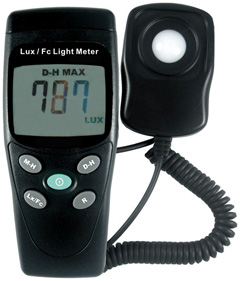
A light meter
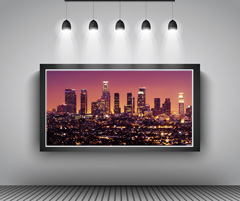
Gallery lighting
|
| THE ART AND SURROUNDINGS
|
 |
Regardless of how perfectly the lighting is arranged, if the artwork is not displayed properly, the viewing experience will be lacking.
THE TYPE OF GLASS
Unless the artwork on display is a canvas, there is a good chance the image will be protected by a glass or plexiglass glazing. While this is ideal for keeping the art safe from dust, dirt, fingerprints and - if it is archival quality glazing - harmful UV light, it also causes an issue when lighting.
Glare is a very detrimental to the viewing experience, but opting for non-glare glazing is not the only solution. Non-glare glazing has been roughed on one side of the pane. This scatters light particles and essentially eliminates reflection. However, in some cases, a non-glare cover causes a loss of radiance in the color of the artwork.
As long as the lighting is installed according to certain specifications, regular glazing should not be problematic. If art is being displayed in an area where ambient lighting is the only option, non-glare glazing could be ideal.
HEIGHT AND ANGLE
In early art galleries, art was hung from floor to ceiling, with the higher pieces tilting out from the wall to be visible to the viewer, who stood below looking up. Today, however, eye level is the widely accepted height for gallery displays. More specifically, the center of the art - or the focal point if this is far removed from the center - should be hung at eye level which is, on average 60" above the ground.
One way to keep glare and other distracting reflections from the glazing covering the art is to tilt the frame just slightly, so it is reflecting the empty space where the top of the opposite wall meets the ceiling. This is not adopted by many galleries, however, as it requires special hanging, can be distracting in itself, and still requires ensuring the light source will not be reflected. Hanging the piece flat along the wall is fine, as long as the lighting is properly arranged.
|
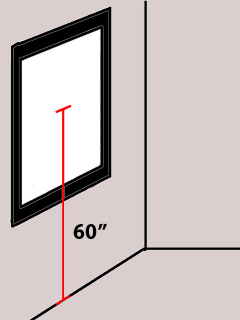
The ideal artwork height
|
| TYPES OF LIGHT
|
 |
XENON
Xenon bulbs are said to be as close to sunlight as man-made light can get (in other words, a very high CRI rating). They use less energy than other common light sources (namely halogens), and are most often seen in camera flashes. However, xenon bulbs are very expensive and can be difficult to find. For this reason, many galleries use halogen lights.
HALOGEN
Halogens cast a very white light, which makes the most of all the colors in artwork. They are a good choice for exhibits because they are less expensive than Xenon or LED lights. However, halogens radiate a lot of heat and must therefore be kept back from the art to avoid hotspots.
LED
Though LED has not traditionally been used in gallery lighting, advances in the field may be changing that soon. Though they are quite expensive at this time, LED bulbs use about 1/3 the energy of xenon bulbs, and emit an extremely white, UV-free light.
INCANDESCENT AND FLUORESCENT
These types of light are those we are most familiar with. Incandescent bulbs are usually used in homes, while fluorescents are in nearly every office in North America. You may have noticed that colors have a bit of a yellow or orange cast when viewed under this type of light.
These lights are warm in tone, which means they highlight the yellows and reds in objects, and "flatten" the blues and greens. They are not ideal for viewing artwork. However, fluorescents should specifically be avoided, as they give off high amounts of UV rays and accelerate fading.
|
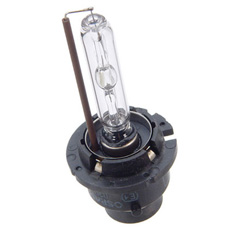
A xenon lightbulb
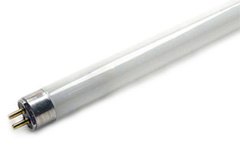
A fluorescent lightbulb
|
| GALLERY LIGHTING FIXTURES
|
 |
TRACK LIGHTING
This style of lighting is very common in galleries, and has even become a popular style in homes due to its modern "industrial" look. Consisting of a narrow bar or "track" that runs along a section of the ceiling, and small lamps that fasten into the track, this lighting style is perfect for wall galleries because the lamps can generally be relocated along the length of the track, and often adjusted to many angles, which makes lighting new pieces or rearranging old ones quite simple.
Barn Doors and Framing Projectors
These accessories can be added to track lights to help direct and alter the beam. Barn doors are black shades that border the light on four sides, thereby confining the light to a specified location. You've most likely seen them on theater lighting.
Framing projectors do much the same thing, but include lenses that allow the user to shape the cone of light exactly how they want. In the case of gallery lighting, they can be used to frame every piece of art flawlessly, with no excess light bleeding off onto the frame or the wall. This specific application of light can create an appealing contrast between art and border/background.
RECESSED CANS
These light figures are common in more modern homes, primarily in hallways and rec rooms. They are made up of a short, oblong tube - the can - which is set into the ceiling so the outer edge is essentially flush with the ceiling. The lightbulb is then placed in this tube, and does not project from the recess at all.
Recessed lights are often adjustable, which makes them useful for lighting art on the walls. Since they are permanent where they are placed, however, one does not have the option of moving the piece over a few feet as with track lighting.
WALL OR FRAME FIXTURE
Alternately, the light fixture may be attached directly to the top of the artwork's frame, or on the wall, either just above the art or with the mounted plate hidden behind the frame. This type of lighting resembles a lamp, generally with a curved neck that directs the light source out and down, over the artwork.
This style is perhaps most often used in instances where a single piece is shown, where installing an entire ceiling fixture would prove unnecessary. It could also be an aesthetic detail, as many of these light fixtures are created to be visually pleasing. If the neck extends far enough, the light source can be pointed at the artwork at an angle very similar to a ceiling mounted fixture.
|
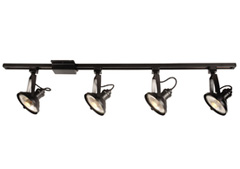
Track lighting, common in galleries
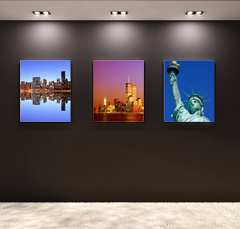
A gallery wall with recessed lighting
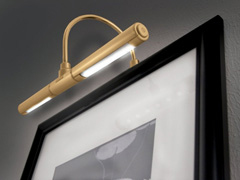
A wall-mounted light fixture
|
| INSTALLATION
|
 |
Each piece of artwork in a gallery should have its own light source, and this source should highlight the art and nothing else. Ideally, the light will reach the exact dimensions of the artwork, keeping direct light from the frame and - most importantly - the wall. If this cannot be accomplished, a slightly wider beam is better than one that does not illuminate the entire artwork. However, light too much of the wall and the viewer's eye will continue beyond the art to be lost in the blank space beyond.
UNDERSTANDING BEAM SPREAD
Beam spread is an important concept when preparing to install gallery lighting. Different lamps have different beam spreads, which is the degree at which the beam expands as the light source is moved away from the object. Spotlights and flood lights are usually named based on this measurement, where a spotlight has a beam spread of less than 15 degrees, and a flood light of more than 30.
This is significant for lighting art for the same reasons barn doors and frame projectors are used - direct light should touch only the artwork, not the frame or the wall if possible.
ANGLE TO THE ART
Of course, the beam spread required for lighting a certain artwork depends on where the light source is placed in relation to the piece. It is widely accepted that the light source should be at 30 degree angle in order to minimize glare. For larger artworks, an angle of 35 degrees will minimize the chance of shadows. If the texture of the art should be the focal point, 25 degrees is ideal.
ACCOUNTING FOR CEILING HEIGHT
As mentioned above, lights that are placed too close to artwork can cause damage by overheating the most direct point (hotspot) or a concentration of UV light rays. Furthermore, in order to achieve the desired 30 degree angle, the light bulb must be placed a specific distance from the wall depending on the height of the ceiling.
A general rule to follow:
- For 8 foot ceilings: place light source 20 - 36" away from the wall.
- For 10 foot ceilings: place light source 40 - 60" away from the wall.
|
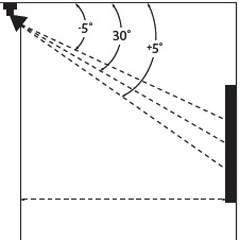
The light source sould be at a 30 degree angle
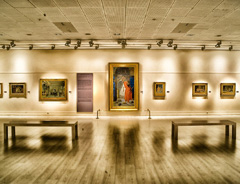
Lighting is an essential aspect of a gallery
|
|
|
If you find yourself with a growing collection of art, a designated space in your home for exhibiting these pieces is something to consider. In such cases gallery lighting is a must, both to ensure the preservation of your pieces and to ensure that everyone - guests and inhabitants alike - get as much out of the viewing experience as possible.
At KeenART Media, we are well equipped to help you start your collection. Our gallery wrapped canvas prints and fine art prints, along with our wide selection of frames and other mounting options means your art collection can be just as diverse and stunning as you always dreamed.
If you have any questions about our products or services, please do not hesitate to contact us. Our knowledgeable staff are always happy to help.
If you need some lighting inspiration, be sure to check out our Pinterest board!
|
|
© 2002-2024 - KeenART Media Ltd.
|
|
| |
|

